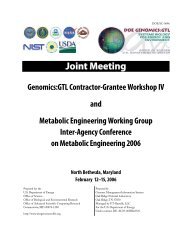Joint Meeting - Genomics - U.S. Department of Energy
Joint Meeting - Genomics - U.S. Department of Energy
Joint Meeting - Genomics - U.S. Department of Energy
Create successful ePaper yourself
Turn your PDF publications into a flip-book with our unique Google optimized e-Paper software.
8<br />
Systems Biology for DOE <strong>Energy</strong> and Environmental Missions<br />
Bi<strong>of</strong>uels > Analytical and Imaging<br />
Technologies for Studying<br />
Lignocellulosic Material Degradation<br />
7<br />
Three-Dimensional Spatial Pr<strong>of</strong>iling<br />
<strong>of</strong> Lignocellulosic Materials by<br />
Coupling Light Scattering and Mass<br />
Spectrometry<br />
P.W. Bohn 1 * (pbohn@nd.edu) and J.V. Sweedler 2<br />
(sweedler@scs.uiuc.edu)<br />
1<strong>Department</strong> <strong>of</strong> Chemical and Biomolecular<br />
Engineering, University <strong>of</strong> Notre Dame, Notre Dame,<br />
Indiana and 2<strong>Department</strong> <strong>of</strong> Chemistry, University <strong>of</strong><br />
Illinois, Urbana, Illinois<br />
Project Goals: The goals <strong>of</strong> the project are to:<br />
(1) develop correlated optical and mass spectrometric<br />
imaging approaches for sub-surface imaging to address<br />
the highly scattering nature <strong>of</strong> LCMs in different<br />
states <strong>of</strong> processing; (2) adapt mass spectrometric<br />
imaging protocols to enable spatially-resolved LCM<br />
characterization; (3) create surface optical and mass<br />
spectrometric measures <strong>of</strong> lignin-hemicellulosecellulose<br />
degradation at specific processing stages; and<br />
(4) correlate the in situ optical (Raman and SH-OCT)<br />
and mass spectrometric information to generate depthresolved<br />
maps <strong>of</strong> chemical information as a function <strong>of</strong><br />
spatial position and processing time.<br />
The physical and chemical characteristics <strong>of</strong> lignocellulosic<br />
materials (LCMs) pose daunting challenges for<br />
imaging and molecular characterization: they are opaque<br />
and highly scattering; their chemical composition is a<br />
spatially variegated mixture <strong>of</strong> heteropolymers; and the<br />
nature <strong>of</strong> the matrix evolves in time during processing.<br />
Any approach to imaging these materials must (1) produce<br />
real-time molecular speciation in formation in situ;<br />
(2) extract sub-surface information during processing;<br />
and (3) follow the spatial and temporal characteristics<br />
<strong>of</strong> the molecular species in the matrix and correlate this<br />
complex pr<strong>of</strong>ile with saccharification. To address these<br />
challenges we are implementing tightly integrated op tical<br />
and mass spectrometric imaging approaches. Employing<br />
second harmonic optical coherence tomography (SH-<br />
OCT) and Ra man microspectroscopy (RM) provides<br />
real-time in situ information regarding the temporal and<br />
spatial pr<strong>of</strong>iles <strong>of</strong> the processing species and the overall<br />
* Presenting author<br />
GTL<br />
chemical degradation state <strong>of</strong> the lignin heteropolymer;<br />
while MALDI and SIMS provide spatially-resolved<br />
information on the specific molecular species pro duced<br />
by pre-enzymatic processing. The goals <strong>of</strong> the approach<br />
are to: (1) develop correlated optical and mass spectrometric<br />
imaging approaches for sub-surface imaging to<br />
address the highly scattering nature <strong>of</strong> LCMs in different<br />
states <strong>of</strong> processing; (2) adapt mass spectrometric<br />
imaging protocols to enable spatially-resolved LCM<br />
characterization; (3) create surface optical and mass<br />
spectrometric measures <strong>of</strong> lignin-hemicellulose-cellulose<br />
degradation at specific processing stages; and (4) correlate<br />
the in situ optical (Raman and SH-OCT) and mass<br />
spectrometric information to generate depth-resolved<br />
maps <strong>of</strong> chemical information as a function <strong>of</strong> spatial<br />
position and processing time.<br />
8<br />
Identify Molecular Structural<br />
Features <strong>of</strong> Biomass Recalcitrance<br />
Using Non-Destructive Microscopy<br />
and Spectroscopy<br />
Shi-You Ding 1 * (shi_you_ding@nrel.gov), John<br />
Baker, 1 Mike Himmel, 1 Yu-San Liu, 1 Yonghua Luo, 1<br />
Qi Xu, 1 John Yarbrough, 1 Yining Zeng, 1 Marcel G.<br />
Friedrich, 2 and X. Sunney Xie 2<br />
GTL<br />
1National Renewable <strong>Energy</strong> Laboratory, Golden,<br />
Colorado and 2Harvard University, Cambridge,<br />
Massachusetts<br />
Project Goals: We propose to exploit recently developed<br />
techniques to image the plant ultrastructure, map<br />
the chemistry <strong>of</strong> cell-walls, and study the time-course<br />
changes during conversion processes. These techniques<br />
are novel and developed or modified specifically for<br />
biomass characterization at the nanometer resolution.<br />
They include atomic force microscopy (AFM), solidstate<br />
NMR, small angle neutron scattering (SANS),<br />
and total internal reflection fluorescence (TIRF)<br />
microscopy. We will also use fluorescence labeling<br />
approaches to map biomass surface chemistry and to<br />
track single enzyme action in vitro and in vivo. For<br />
example, one novel technique under development is<br />
to integrate AFM with TIRF-M capability to permit<br />
us to image the cell-wall substrate at the nanometer<br />
spatial resolution and to track single cell-wall/enzyme/<br />
cellulosome-substrate interaction. The application <strong>of</strong><br />
these advances to the study <strong>of</strong> plant cell walls, and par-





